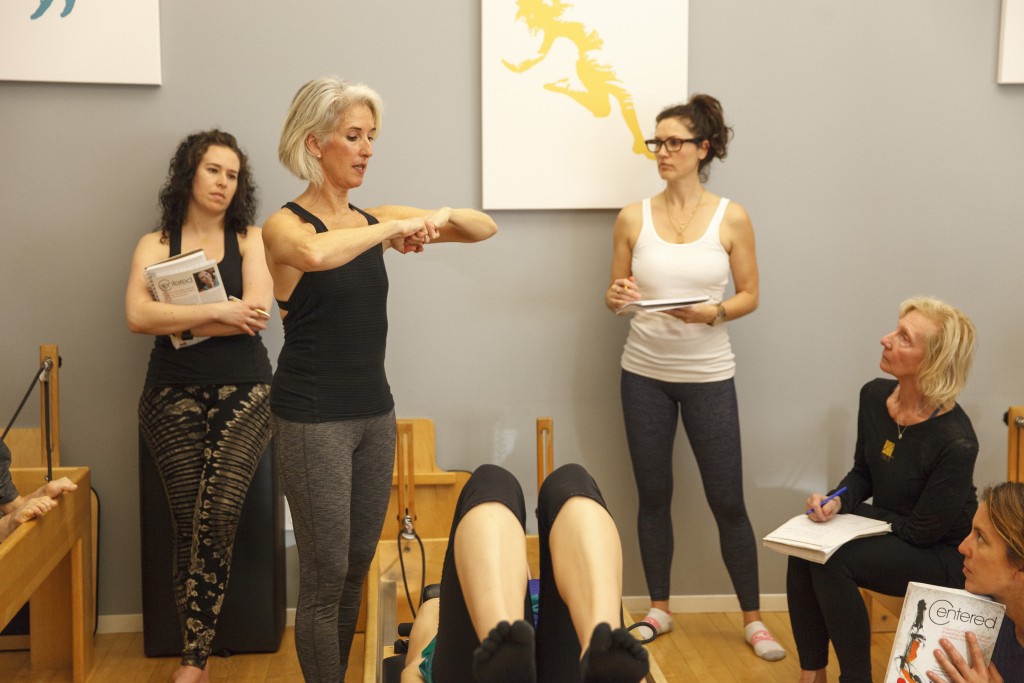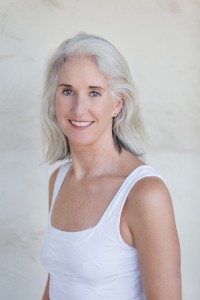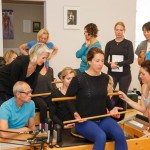Finding Your Own Voice
By Madeline Black
January 23, 2019
We invest a great deal into our life as a Pilates teacher. We spend hours, weeks and months studying and practicing Pilates. Then it takes time to synthesize the process of what was learned and embody the work before teaching it to others. After completing a training, you go out and begin to teach. Young teachers repeat what their teachers taught them, trying to be like them. It becomes a script and they believe it is the correct way to teach clients. Others use an amplified personality as a strategy to engage the clients, which becomes more of a performance rather than meeting the client for their needs. There are other strategies teachers may use that present themselves from an exterior place rather than from their authentic self.

For a period of time, these styles of teaching serve the teacher. At some point, what arises is a questioning of what had been taught and becoming aware of the desire to know more. It may feel as if you are posing rather than being comfortable in what you do know and the gifts you offer. Until you bring in your voice, teaching can limit you. Allowing your voice to shine through expands your self and opens the pathway for growth with a greater impact on your clients.
Where is the “you” in your voice? Maybe you have not thought of finding your own voice. Or have thoughts such as “So many other teachers say it so much better than I”, or “I was taught to say it in this way.” Another possible thought is, “Who wants to hear it?” These are the critical mind distractions that block the possibility of bringing your self into your practice.
I am not only speaking about verbal cueing. Your physical presence, touching skills and organizing the movements to best address each client’s needs are all aspects that encompass what I call your voice. Your voice evolves from the integration of all of your experiences from study, including your personal life. What I am calling your voice is the essence of who you are, have become and wish to bring forth into your work. It requires questioning the beliefs you were taught and answering to yourself; integrating what you know, while continuing to explore new ideas and feel the freedom to bring it into your teaching.
The lifetime commitment to teaching Pilates and teaching from your voice will feed and energize you. Sharing what you love from your heart while knowing deep inside how to connect with someone seeking your guidance to improve their life is beyond any reward I can image. The source is you and how you synthesized the study and practice. For me, learning to see how the body moves based on the knowledge of movement science, manual work and integrating this knowledge into the Pilates method was the voice I found. My voice continues to open by conveying my knowledge to others and guiding teachers toward their essence of their work.

Whether you are teaching within a classic paradigm or adapting the method, your voice can be present. Evolving your teaching means finding your way rather than emulating someone else as your voice. There is a time and space for teachers to feel supported in exploring their own voice with the integration of the body of work learned. And receiving confirmation of your work helps bring clarity to your beliefs rather than trying to get you to believe in something outside of yourself. To be with a mentor, someone who inspires you not for what they can do but rather what they can do for you, is a special relationship and can be the environment to find support to grow. However, it is not readily available for most teachers. There are ways for you to self-investigate. Below, I offer you food for thought and practice.
Here are some suggested exercises to develop sensing your voice:
- Sit quietly: ask yourself “What does my voice sound like?”, “What would it be like to teach being me?”, “Am I trying to emulate someone else?”
- Listen to yourself: As you begin to listen, hear your words, notice how the client responds.
- Sing: vocalize sounds that resonate with you. Try short phrases such as “I am”. Say your name and visualize your name occupying every cell of your body.
- Visualize an energy field around you, see how it moves from the ground through your center, out the top of your head and around your body and back into the ground and flow up the center again. Imagine a fountain flowing continuously.
- Play with touch, feel hard surfaces and think bone, feel soft surfaces and think connective tissue. Then lightly touch someone else and see if you can feel the different structures, bone, skin, and fascia.
- In a public place, sit and observe people walking and try to identify the strategy they are using to walk, do they pull themselves or push themselves? Where is their center of gravity?
- Write possible movement sequences to address what you observed that would benefit the person’s movement patterning.
- Ask lots of questions of yourself and especially when in a studying environment.
Madeline Black teaches her immersive trainings biannually in London, San Francisco, New York, and Shanghai, and annually in Singapore. In 2020, Tokyo, Dublin, Dortmund and Sweden are planned in addition to her annual locations. Her book, “Centered: Organizing the Body through Kinesiology, Movement Theory and Pilates Techniques” is available in English, Spanish and soon Italian, Korean and Chinese. Contact her at madeline@madelineblack.com, check her website for dates and registration www.madelineblack.com.
Madeline  Black has distinguished herself as an international leader in movement and exercise education. She has been known as the “teacher’s teacher” for over 25 years. Madeline’s first comprehensive book, “Centered, Organizing the Body Through Kinesiology, Movement Theory and Pilates Techniques”, which defines the synthesis of her approach to movement training was published in 2015. Madeline presents regularly in over 20 countries and for conferences such as Pilates On Tour, and Pilates Method Alliance. She is regular teacher online for Pilates Anytime and Fusion Pilates EDU.
Black has distinguished herself as an international leader in movement and exercise education. She has been known as the “teacher’s teacher” for over 25 years. Madeline’s first comprehensive book, “Centered, Organizing the Body Through Kinesiology, Movement Theory and Pilates Techniques”, which defines the synthesis of her approach to movement training was published in 2015. Madeline presents regularly in over 20 countries and for conferences such as Pilates On Tour, and Pilates Method Alliance. She is regular teacher online for Pilates Anytime and Fusion Pilates EDU.
What sets Madeline’s teaching apart is her emphasis on clear instruction. From her lecture demos, to her hands-on work, to her educational and supplemental materials, participants leave her workshops immediately able to integrate her ideas and concepts into sessions with their own clients. She draws inspiration from a vast knowledge of anatomy, fascia research, biomechanics, and energy work, which has lead to an innovative, interdisciplinary approach to Pilates, yoga, and GyrotonicÒ. Madeline’s accessibility, articulateness, commitment to Pilates, and decades of experience, make her a beloved and sought-after instructor.

